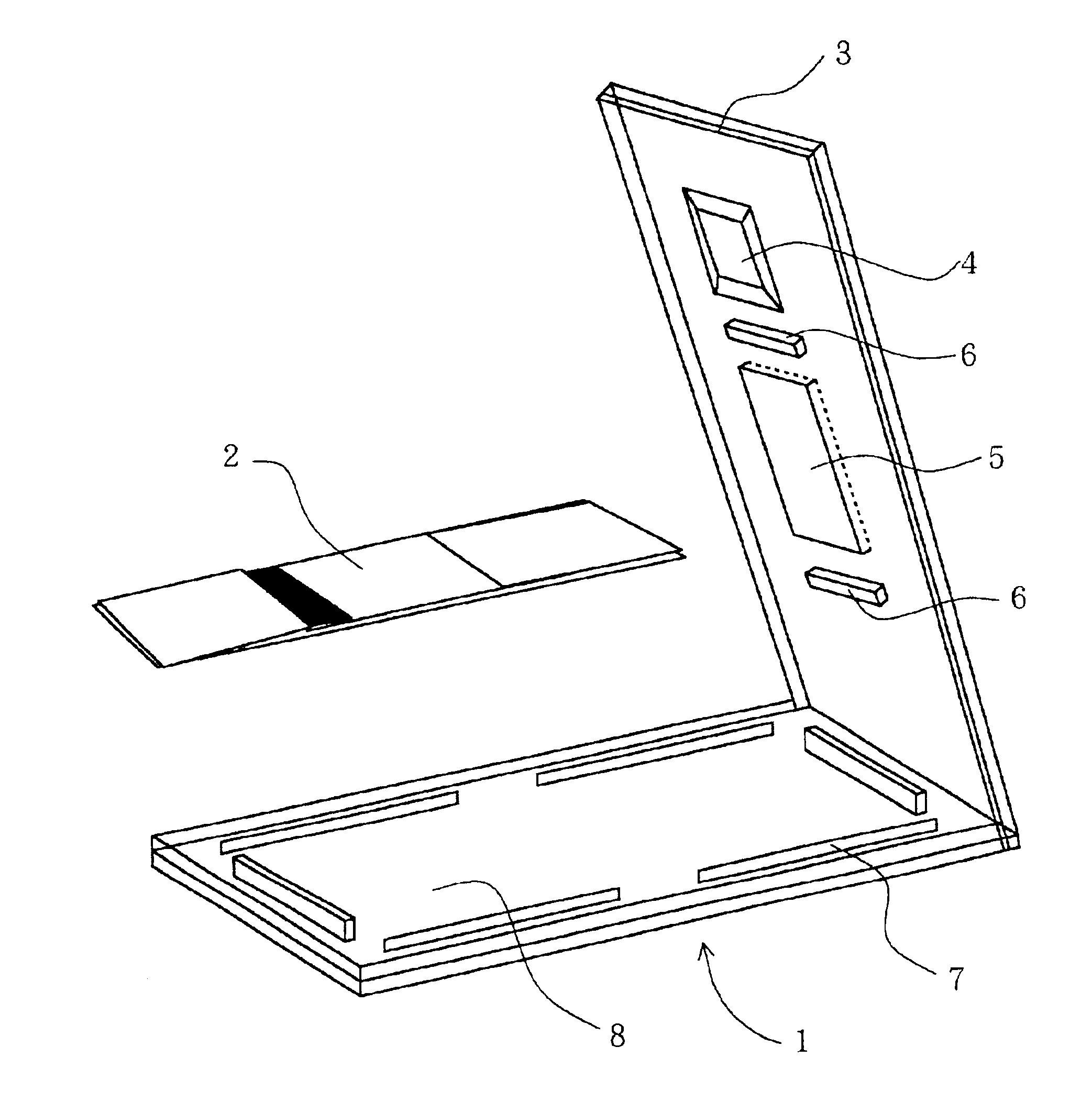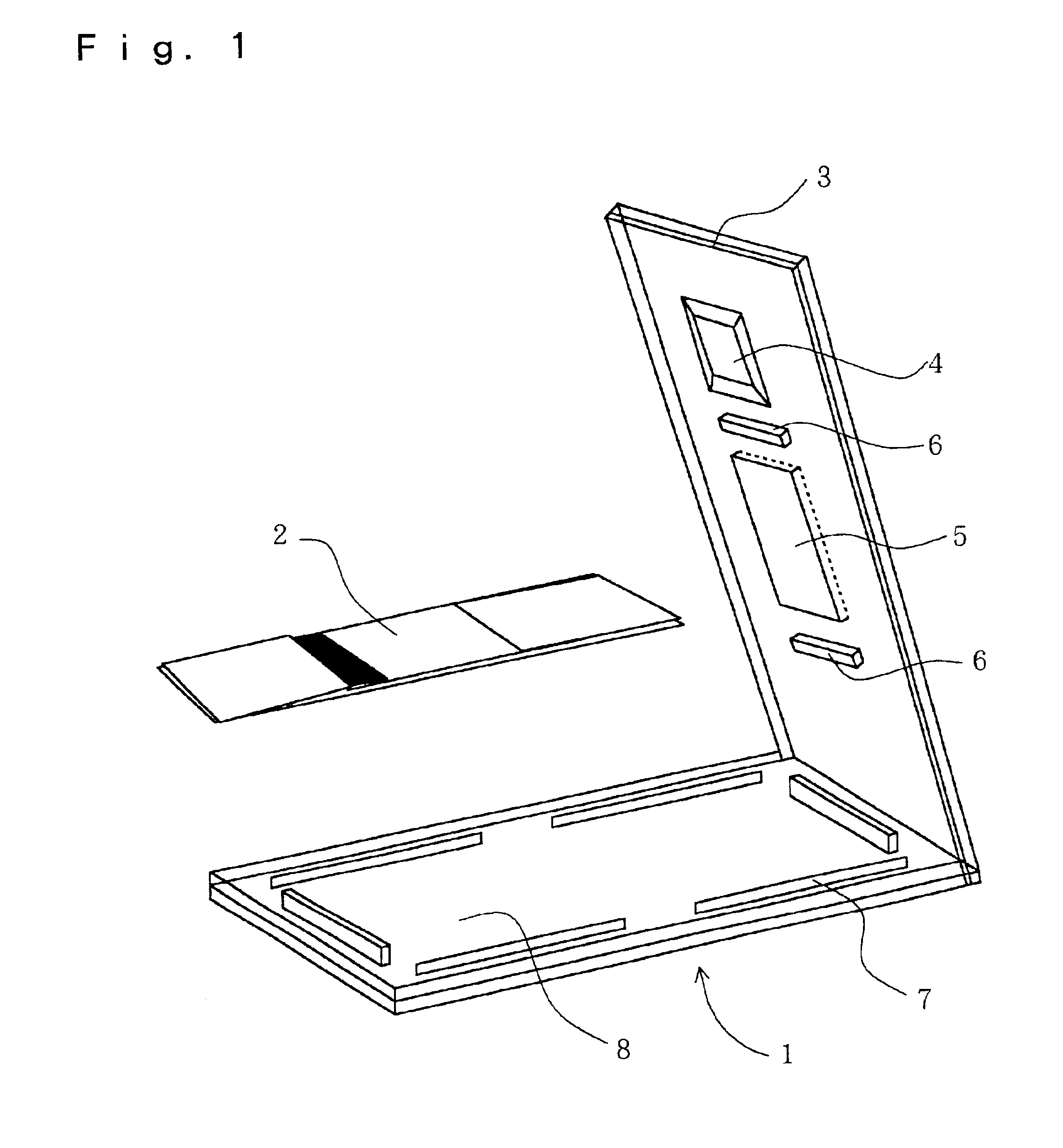Housing of immunochromatography apparatus
a technology of immunochromatography and apparatus, which is applied in the field of storage of immunochromatography apparatus, can solve the problems of contaminating the developing strip, erroneous diagnosis, and liquid may stop penetrating in the middle of the strip or may be too late to reach the detection site, and achieves accurate detection of the test substance contained and stable judgment results.
- Summary
- Abstract
- Description
- Claims
- Application Information
AI Technical Summary
Benefits of technology
Problems solved by technology
Method used
Image
Examples
example 1
When colloidal gold is used as a marker label to be contained in a developing strip, colloidal gold shows a red—red purple hue (Munsell color atlas: 2.5 PR-2.5 R) and a maximum absorption wavelength of 510-540 nm.
A high level of visibility can be obtained by selecting, for the developing strip, a blue green—green (Munsell color atlas: 2.5 BG-2.5 G) housing and an observation window of the housing which, from the shade of color viewpoint, shows a high spectral reflectivity at 500-560 nm, preferably at about 510-540 nm, as measured by using a Minolta Co. Ltd. spectral calorimeter.
While the label or marker substances to be used in immunochromatography include colored liposomes, colored polymer beads, metal-containing dye particles, enzymes and so forth, it is possible, by using the same principle as in this Example 1, to select the color hue of the housing so that it may be suited for the label substance used or the product resulting from enzymatic conversion of a substrate.
example 2
Colored housings were evaluated using an immunochromatographic strip for detecting the type B hepatitis surface antigen (HBsAg) with colloidal gold particles as the label substance. Five housings differing in color, inclusive of the blue green—green colored housing described in Example 1, were prepared (No. 1 to No. 5: light purple, jade green, white, light green, transparent) and the immunochromatographic strip for detecting HBs antigen was set in each housing. The color, the hue (Munsell system), the transmittance of the housing body and the transmittance of the observation window for each of the five housings were as shown below in Table 1. The transmittance measurement was performed at the wavelength of 660 nm using a Shimadzu Co. Ltd. model UV-1200 spectrophotometer. The transmittance of the body proper and of the observation window of each housing was determined using a quartz cell as a blank (transmittance 100%). The transmittance ∠ is expressed as follows:
∠=ΦtΦi
where Φt is ...
example 3
Immunochromatographic strips were prepared by allowing known concentrations of HBsAg (5 ng / ml, 2.5 ng / ml) to react on developing strips to cause a detection line to appear on each strip. Very thin plastic filters (thickness 0.25 mm, transmittance 80%) were piled up on each immunochromatographic strip to give a simulated housing membrane corresponding to a housing with a transmittance as shown below in Table 2. The number of filters laid up was increased one by one from 1 to 16. The thus-obtained 16 simulated housing membranes showing different transmittance values were examined for two items, namely the visibility of the sample developed and the test lines (antibody concentrations of 5 ng / ml and 2.5 ng / ml). The transmittance measurement was carried out at the wavelength of 660 nm using a Shimadzu model UV-1200 spectrophotometer. The results obtained are shown below in Table 2.
TABLE 2Test line visibilityNumberTrans-VisibilityPositiveVisible limitofmit-of samplelimitconcentrationfilte...
PUM
| Property | Measurement | Unit |
|---|---|---|
| transmittance | aaaaa | aaaaa |
| transmittance | aaaaa | aaaaa |
| transmittance | aaaaa | aaaaa |
Abstract
Description
Claims
Application Information
 Login to View More
Login to View More - R&D
- Intellectual Property
- Life Sciences
- Materials
- Tech Scout
- Unparalleled Data Quality
- Higher Quality Content
- 60% Fewer Hallucinations
Browse by: Latest US Patents, China's latest patents, Technical Efficacy Thesaurus, Application Domain, Technology Topic, Popular Technical Reports.
© 2025 PatSnap. All rights reserved.Legal|Privacy policy|Modern Slavery Act Transparency Statement|Sitemap|About US| Contact US: help@patsnap.com



